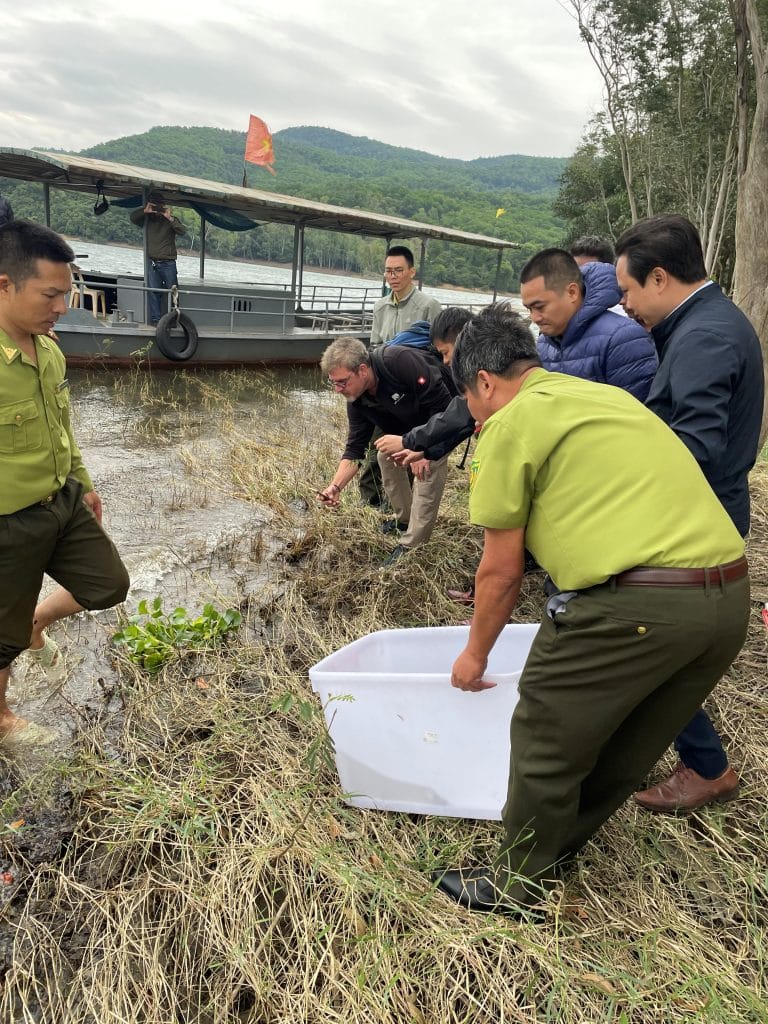Breeding programs initiated in Vietnam to help turtle species threatened by extinction
Conservationists have initiated breeding programs in Vietnam to recover spotted softshell turtle populations threatened by overconsumption and habitat loss. Based on a literature study, field surveys across Vietnam, and genetic screenings of collected samples, researchers estimated the range and conservation status of Pelodiscus variegatus, the spotted softshell turtle. The data were then used to model the species’ potential range in Vietnam.

Conservation breeding programs are intended to support the protection of the endangered spotted softshell turtle. In order to find out more about their occurrence on the Indochinese mainland, researchers have now published a study on habitat suitability and distribution patterns in the journal Nature Conservation. The study combines molecular analyses and species distribution modeling to identify priority conservation areas.
The study was published with the participation of the Vietnam Academy of Science and Technology (VAST), the Vietnam National University Hanoi and the Asian Turtle Program (Vietnam), as well as the Cologne Zoo and the Leibniz Institute for the Analysis of Biodiversity Change (LIB).
The spotted softshell turtle (Pelodiscus variegatus) has been known from Vietnam and Hainan Island, China, since 2019. It is considered a delicacy in these countries. In China alone, hundreds of millions of turtles are traded every year, making them the most consumed turtles in the world. Habitat loss and degradation, competition with non-native turtle species and habitat pollution are further reasons for the species’ decline.
Although several protected areas in Vietnam appear to offer suitable habitats for this turtle species, the researchers were unable to detect populations in any of the areas studied. “We therefore assume that the spotted softshell turtle is particularly threatened with extinction,” emphasizes PD Dr. Dennis Rödder, Curator of Herpetology at the Museum Koenig Bonn of the LIB.
The results of the ecological modeling show that Pelodiscus variegatus may also occur in Laos. “However, on the border between Vietnam and Laos and in wetlands, we were only able to find patchy evidence of it,” says Rödder, describing the modeling.
Vietnamese conservationists, in collaboration with Prof. Dr. Thomas Ziegler from Cologne Zoo, have launched conservation breeding programs in Vietnam to save populations of the spotted softshell turtle that are threatened by overconsumption, habitat loss and mixing with invasive species.
The researchers calculated the distribution range and conservation status of the spotted softshell turtle based on a literature review, field studies across Vietnam and genetic studies of collected samples. The data was used to model the potential range of the species in Vietnam.
To restore the species’ natural populations, the Institute of Ecology and Biological Resources (IEBR, VAST) in Vietnam and Cologne Zoo have launched an in-country conservation breeding program. By the end of 2023, 50 young and healthy turtles had already been released into the wild in a location with a suitable climate and habitat in northern Vietnam.
Based on the results of the study, it is hoped that further individuals can be reintroduced into protected areas in north-central Vietnam, the distribution center of the spotted softshell turtle. In this way, the consortium hopes to stem the decline of the species and make a further contribution to the global “Reverse the Red” movement – by applying the IUCN’s “One Plan Approach to Conservation”, in which all available expertise works together to optimize species protection.
Soft-shelled turtles of the genus Pelodiscus are widespread from south-eastern Siberia to China and Vietnam. However, human transportation and breeding activities have extended their range to Indonesia, northern Australia, western Europe, North America, Hawaii and Mauritius.
Traditionally, this genus was considered monotypic, i.e. with only one recognized species, the Chinese softshell turtle (Pelodiscus sinensis). However, recent research has shown that the genus is much more diverse and at least seven species are known to science, which consequently have smaller distributions and are more threatened.
“Due to their morphological similarity, expanding settlements and agricultural activities, overexploitation and aquatic lifestyle, it is often difficult to study them in their natural habitat to better understand their distribution as well as their population and conservation status,” says Rödder. “Unfortunately, only part of the species’ potential range is protected so far and there is no known evidence from protected areas, which underlines the need for extended or even new protected areas.”
Original study:
Le MD, Rödder D, Nguyen TT, The Pham C, Nguyen TQ, Ong AV, McCormack TEM, Nguyen TT, Le MH, Ngo HT, Ziegler T (2024) Climatic niche modelling and genetic analyses highlight conservation priorities for the Spotted Softshell Turtle (Pelodiscus variegatus). Nature Conservation 55: 67-82. (PDF)
